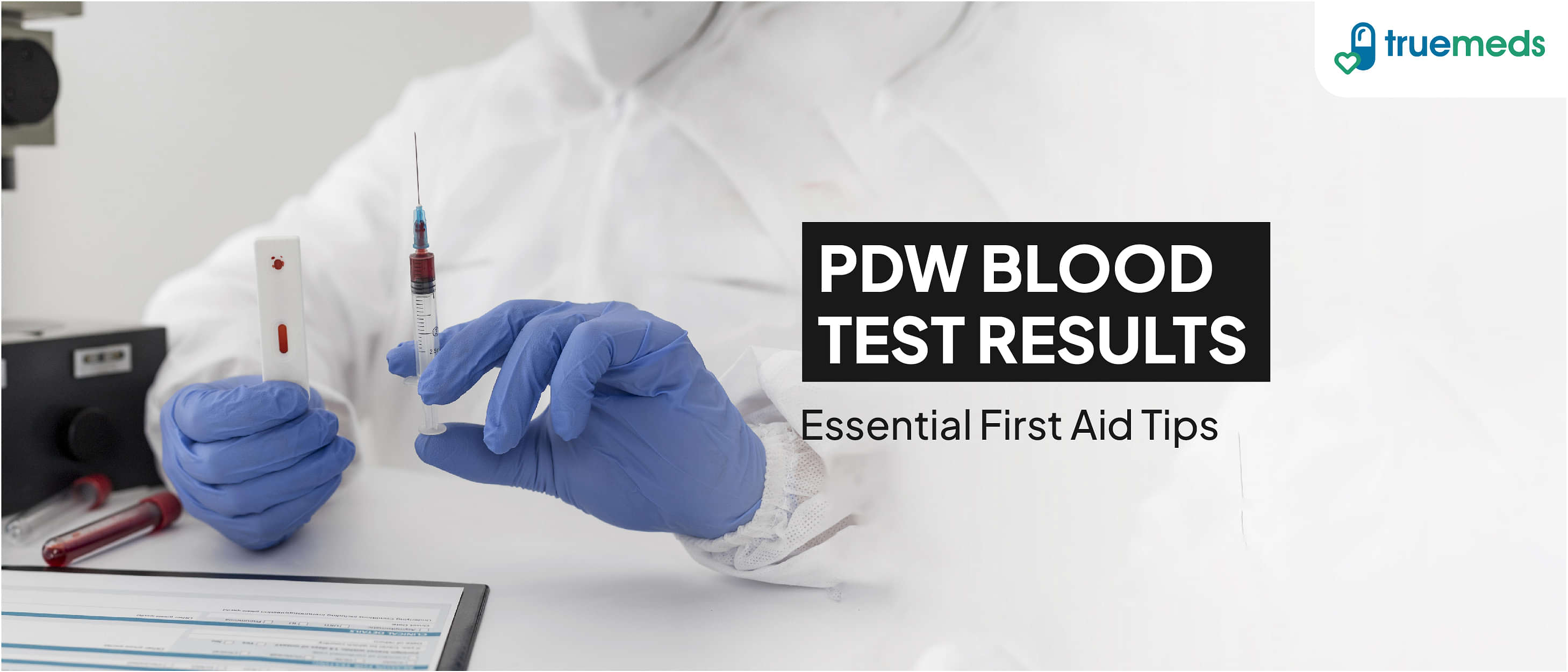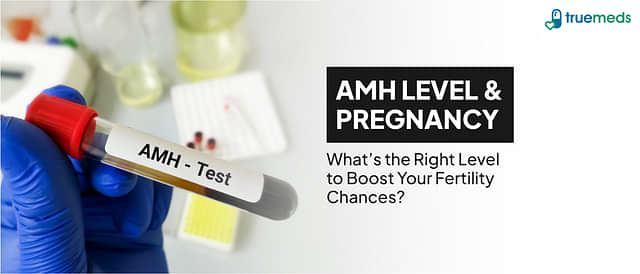Platelet Distribution Width (PDW) Blood Test: Interpretation, Management, and Related Disorders
Last updated on : 30 Nov, 2025
Read time : 10 min
You don’t always need complex scans or costly procedures to assess your health; sometimes, a routine blood test can provide valuable insights. One such test, often included in a complete blood count (CBC), is the Platelet Distribution Width (PDW) blood test.
While often used as a supportive indicator, the PDW test can reveal insights into how your platelets behave, potentially signalling underlying conditions ranging from nutrient deficiencies to chronic inflammatory states or cardiovascular risk factors [1], [2].
In this blog, we explain what PDW means, why it matters, and how regular monitoring can be a useful tool for your doctor in early detection and personalized care.
Key Highlights
- PDW measures the variability in platelet size, which can offer clues about platelet activation and function.
- High PDW can be an indicator in conditions like inflammation, certain cancers (tumors), blood disorders, and cardiovascular or chronic lung diseases [3], [4].
- The key to managing an abnormal PDW is tackling the root cause—this could involve treating the primary disease, addressing a nutrient deficiency, or initiating other evidence-based medical treatments under a doctor’s guidance.
- Regular monitoring of your PDW and other platelet indices can provide crucial insights into your health condition for your healthcare provider.
What is PDW?
Platelets are small, disc-shaped blood cells produced by megakaryocytes in the bone marrow. They play a crucial role in hemostasis, the process of forming clots to stop bleeding. Platelet Distribution Width (PDW) is a statistical measure that quantifies the heterogeneity, or how much the size of these platelets varies in your blood sample.
Depending on the laboratory and analyser used, the typical adult PDW reference range is approximately 9.0% to 17.0% [5]. However, it’s important to understand that levels can be influenced by various factors such as age, sex, genetic traits, platelet activation disorders, and certain types of anemia (like iron deficiency anemia).
A high PDW indicates greater variability in platelet size, often due to a higher proportion of larger (more immature or activated) platelets in circulation. These activated platelets may signal an ongoing response to injury, inflammation, or an underlying disease process [1].
Understanding your PDW levels can offer supplementary insights into your health and help guide further diagnostic steps. Regular check-ups with your doctor can ensure any abnormalities are addressed promptly.
Did you know!
Beyond clinical diagnostics, PDW has been investigated for its potential role in forensic science. Forensic pathologists may use PDW readings to help determine causes of death such as distinguishing sudden cardiac death from other causes highlighting its fascinating application at the intersection of medicine and law. This remains a specialized area of research, not standard clinical practice.
How is the PDW Blood Test Performed?
The PDW blood test is a crucial component of routine medical check-ups when assessing blood components. This test measures the variability in the size of platelets in our blood, giving us insight into the range of sizes in which platelets come.
The PDW blood test is usually performed as part of a larger evaluation and is almost always included in a Complete Blood Count (CBC) or a platelet function assessment.
Here’s a simple step-by-step explanation of how the PDW blood test is done:
- A trained healthcare professional uses a small needle to collect a blood sample, typically from a vein in your arm. The process involves minimal discomfort and lasts just a few minutes.
- Once the sample is collected, it is carefully stored in a tube containing an anticoagulant.
- The tube is then sent to a laboratory and analyzed using an automated haematology analyser.
- This machine calculates the PDW value by examining the size variation of platelets in the blood sample.
- After the analysis, your doctor will receive and discuss the results with you in the context of your overall health and other blood parameters.
Normal PDW Range and Interpretation
The standard reference interval for PDW typically falls between 9.0% and 17.0% for adults, though specific lab values may differ. Always refer to the range provided by the lab that processed your blood [5].
- A PDW value within the normal range signifies more uniform platelet size, which usually suggests normal platelet function in the absence of other symptoms or abnormal test results.
- A PDW value above 17.0% (or the upper limit of the specific lab’s range) indicates a greater variability in platelet size, which can be a sign of increased platelet activation.
- A low PDW (below 9.0%) means your platelets are highly uniform in size. This can be normal, but if accompanied by a low platelet count (thrombocytopenia), it may be associated with conditions like aplastic anemia or side effects of chemotherapy [2].
It’s important to note that abnormal PDW values have been statistically associated with several health concerns. Therefore, it is important to monitor PDW and other platelet indices regularly as part of a broader health assessment.
Understanding High PDW
A high PDW, often defined as a value above the laboratory’s reference range (e.g., >17.0%), suggests greater variability in platelet size, which implies increased platelet activation.
Here’s what an elevated PDW may be associated with, according to various studies:
Cardiovascular Risk: Elevated PDW is often linked to a higher risk of adverse outcomes and increased mortality in patients with existing cardiovascular diseases (CVD), as activated platelets play a central role in plaque rupture and thrombosis [1], [2].
Inflammatory States: High PDW can be an indicator of chronic inflammation, often seen in conditions like diabetes mellitus, rheumatoid arthritis, or other chronic inflammatory disorders [3].
Oncology/Cancer: High PDW values have been studied as a potential prognostic marker in the progression and prognosis of long-term diseases like certain types of cancer [4].
Other Conditions: It can also be associated with bleeding disorders, thyroid disorders, and, in some cases, early signs of preterm birth in pregnant women [2].
It is crucial to understand that an elevated PDW is a non-specific finding; it does not diagnose any single condition but rather acts as a risk or prognostic marker that warrants further clinical investigation by a doctor.
Managing High Platelet Distribution Width
Now that we understand what high PDW might indicate, let’s consider how one might manage it.
The key to managing high PDW is identifying and treating the underlying cause or disease. PDW is a reflection of an underlying process, not the disease itself. Here are some strategies that doctors might recommend:
- Treating the Primary Disease: Undergoing treatment for the primary disease causing platelet activation, such as managing cardiovascular disease, treating chronic respiratory disorders, or managing an autoimmune condition.
- Addressing Nutritional Deficiencies: Managing nutritional deficiencies, such as iron deficiency anemia, through diet or supplements, which can sometimes cause a variation in platelet size.
- Pharmacological Management: Antiplatelet therapy may be considered if high PDW is due to abnormal platelet function in the context of high cardiovascular risk, but this is a decision made by a physician after full risk assessment.
- Monitoring: Regular monitoring of PDW along with other platelet indices to track disease progression and treatment response.
While these steps can help manage high PDW, remember that they should be exclusively guided by your doctor’s advice.
Diagnosis and Management of Platelet Disorders
Diagnosing primary platelet disorders involves various tests, including blood tests, genetic tests, and, in some instances, even bone marrow examination. The key tests typically include the following:
- Complete Blood Count (CBC) with Differential: Used to check the number of platelets and their indices (like PDW and Mean Platelet Volume, or MPV).
- Platelet Function Tests: Assess the effectiveness of your platelets to aggregate and adhere to form a clot.
- Genetic Testing: Which is used primarily for diagnosing inherited disorders of platelet production or function.
The treatment plan varies depending on the specific disorder and its severity.
Some standard treatment options include:
- Medications to boost platelet production or prevent their destruction.
- Platelet transfusions, especially in cases of severe bleeding or very low platelet counts.
- Addressing the underlying cause, such as managing autoimmune disorders with immunosuppressive therapy.
- Avoidance of certain medications that affect platelets, like aspirin or NSAIDs, unless medically necessary.
Takeaway
The PDW (Platelet Distribution Width) blood test is a non-specific but valuable indicator in assessing your overall health. It measures the variation in platelet size, which can provide evidence of potential underlying conditions such as chronic inflammation, hematological issues, or heightened cardiovascular disease risk.
Elevated PDW levels often point to the need for further clinical investigation and may require treatment of root causes like anemia, chronic illness, or undiagnosed inflammatory disease. Regular PDW monitoring, alongside other platelet indices, helps clinicians detect abnormalities early and tailor care to each patient’s needs. Always discuss your results with your physician.
Frequently Asked Questions (FAQs)
What happens if PDW is high?
A high PDW indicates a larger variation in platelet size, which is often associated with underlying health conditions like inflammation, diabetes, heart disease, or cancer. Your doctor will order additional tests to determine the specific cause and risk.
What does low PDW mean in a blood test?
A low PDW means your platelets are uniform in size. While this can be normal, if your platelet count is also low, it may hint at conditions like aplastic anemia or chemotherapy side effects. Consult your doctor for a diagnosis.
What does a normal PDW mean?
A normal PDW, typically between 9.0% and 17.0% (check your lab report’s specific range), means platelet size variation is within an acceptable range, usually indicating no serious platelet-related health issues. It’s a reassuring finding but must be considered with all other test results and your clinical presentation.
Can vitamin D deficiency cause high PDW?
Direct clinical evidence establishing a causal link between simple vitamin D deficiency and an isolated high PDW is limited. Some studies have noted an association, likely due to Vitamin D’s role in inflammation and immune regulation, but it is not considered a primary cause [6].
How to manage high PDW?
The management of high PDW involves addressing the underlying cause identified by your doctor. This may include specific medical treatments for the diagnosed condition, managing inflammation, or making lifestyle changes. Always follow your doctor’s advice in this regard.
References
[1] Vagdatli, E., Gounari, E., Lazaridou, E., Katsibourlia, E., Tsikopoulou, F., & Labrianou, I. (2010). Platelet distribution width: a simple, practical and specific marker of activation of coagulation. International Journal of Laboratory Hematology, 32(3), 250-255. https://pmc.ncbi.nlm.nih.gov/articles/PMC2843567/
[2] Tzur, I., Barchel, D., Izhakian, S., Swarka, M., Garach-Jehoshua, O., Krutkina, E., Plotnikov, G., & Gorelik, O. (2019). Platelet distribution width: a novel prognostic marker in an internal medicine ward. Journal of Community Hospital Internal Medicine Perspectives, 9(6), 464–470. https://doi.org/10.1080/20009666.2019.1688095
[3] Wang, L., Shen, L., Zhao, Y., Pudasaini, B., Zhao, Q., Gong, S., Zhang, R., Yuan, P., He, J., Luo, C., Qiu, H., Liu, J., & Jiang, R. (2021). Survival in severe pulmonary hypertension due to chronic lung disease: influence of in‐hospital platelet distribution width. Pulmonary Circulation, 11(3), e2021102648. https://doi.org/10.1177/20458940211026484
[4] Smith, S. (2023, October 23). Understanding your blood test results. Roswell Park Comprehensive Cancer Center. https://www.roswellpark.org/cancertalk/202310/understanding-your-blood-test-results
[5] Perini, G. F., & Rodrigues, R. E. (2016). Reference ranges for platelet parameters in a healthy adult population. Revista Brasileira de Hematologia e Hemoterapia, 38(4), 346–349. https://doi.org/10.1016/j.bjhh.2016.03.003
[6] Poli, P. V., Zappalà, M. E., & Di Pasquale, R. (2022). Association between vitamin D status and platelet distribution width in patients with chronic inflammatory diseases. Journal of Inflammation Research, 15, 2491–2498. https://doi.org/10.2147/JIR.S360341
Disclaimer
Our healthcare experts have carefully reviewed and compiled the information presented here to ensure accuracy and trustworthiness. It is important to note that this information serves as a general overview of the topic and is for informational purposes only. It is not intended to diagnose, prevent, or cure any health problem. This page does not establish a doctor-patient relationship, nor does it replace the advice or consultation of a registered medical practitioner. We recommend seeking guidance from your registered medical practitioner for any questions or concerns regarding your medical condition.
Popular Articles
Recommended Articles
Recent Articles
Company
About UsHealth ArticleHealth StoriesHealth LibraryDiseases & Health ConditionsAyurvedaUnderstanding Generic MedicinesAll MedicinesAll BrandsNeed HelpFAQSecuritySubscribe
Registered Office Address
Grievance Officer
Download Truemeds
Contact Us
Our customer representative team is available 7 days a week from 9 am - 9 pm.
v4.10.3
2025 - Truemeds | All rights reserved. Our content is for informational purposes only. See additional information.
Our Payment Partners














































